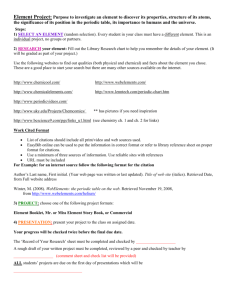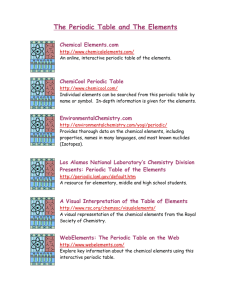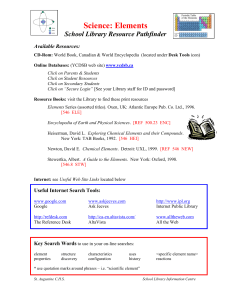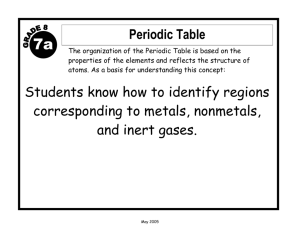WebQuest Instructions
advertisement
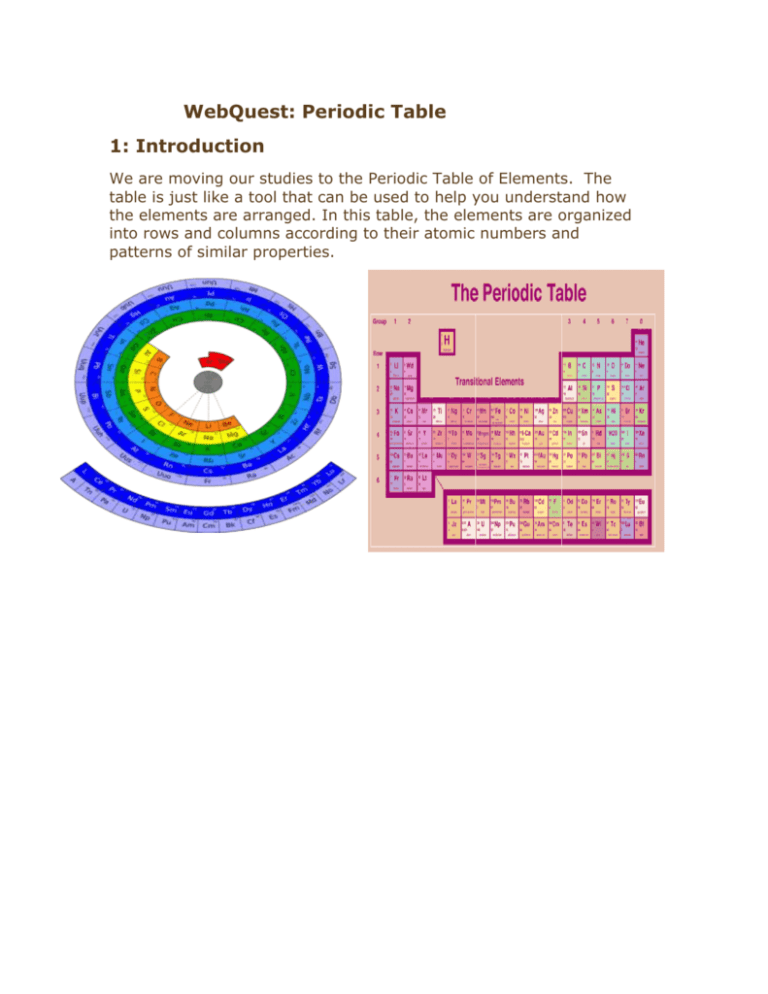
WebQuest: Periodic Table 1: Introduction We are moving our studies to the Periodic Table of Elements. The table is just like a tool that can be used to help you understand how the elements are arranged. In this table, the elements are organized into rows and columns according to their atomic numbers and patterns of similar properties. 2: Background The first Periodic Table dates back over 100 years! Ancient civilizations believed there were four elements; fire, earth, air and water. The table of elements has changed to included elements such as gold, silver, tin, copper, lead, and mercury for tools. But, it was not until 1869 when a Russian chemist named Dimitri Mendeleev created the first chart to organize the 63 elements discovered by this date. As the number of known elements grew, scientists began to recognize patterns in properties and to develop additional ways to classify them. 3: Outcome Research and document information about one element. Record all information on Mr. Brosovich’s jump drive. 4: Steps 1. Select an element from the Periodic Table to explore. http://education.jlab.org/itselemental/index.html 2. Write your name and your partners name & the element you want to research on a post it note, and place post it on the class Periodic Table. ( Only one element per class period) 3. Write and answer these questions in your ejournal: 1. What is the name of your element? 2. What is the symbol for your element? 3. What is the atomic number? 4. What is the atomic mass? 5. What is your element used for? 4. Develop 2 more questions about your element and write the questions and answers in your ejournal. 5. Use at least 3 of the 5 listed websites to answer your questions. http://education.jlab.org/ http://www.chemicalelements.com http://www.chemicool.com http://www.webelements.com http://www.chem4kids.com/files/elem_intro.html (this site focuses on the first 18 elements 6. Answer reflection questions in your ejournal. 5: Resources Periodic Table links: http://education.jlab.org/ http://www.chemicalelements.com http://www.chemicool.com http://www.webelements.com http://www.chem4kids.com/files/elem_intro.html (this site focuses on the first 18 elements) http://periodic.lanl.gov/default.htm http://www.dayah.com/periodic/ http://www.periodictable.com/ http://www.lenntech.com/Periodic-chart.htm http://www.rsc.org/chemsoc/visualelements/PAGES/pertable_fla.htm 6: Evaluation You will be evaluated on how well you develop and answer questions about your element using this rubric. Meets Standard = 15 Points Questions Answered 5 questions in step #3? 5 points Developed 2 more questions about your element in step #4? 2 points Answered 2 questions you developed in step #4? 2 points Used 3 websites listed in Resources to answer questions about your element? 3 points Bonus point: Used 4 - 5 websites to answer questions? 1 point Answered Reflection questions? 2 points TOTAL 14 - 15 points 7: Reflection In your oblog or notebook, write answers to these questions: 1. How might understanding how to use the Periodic Table be useful? 2. Compare and contrast your knowledge before and after your research on your element

